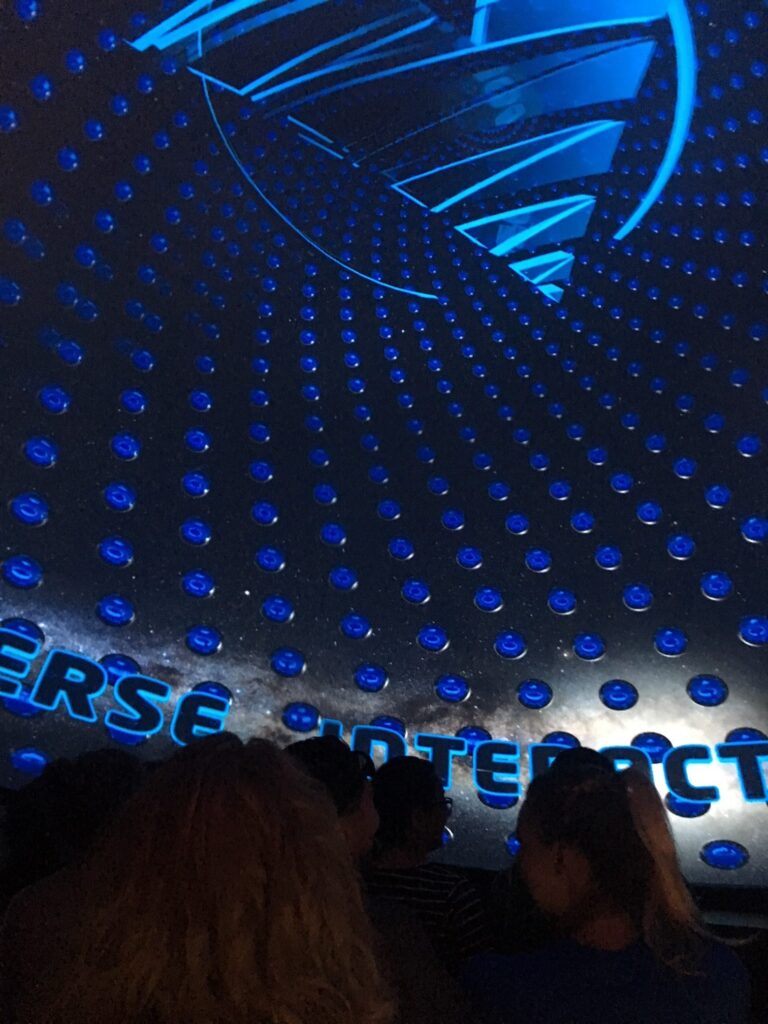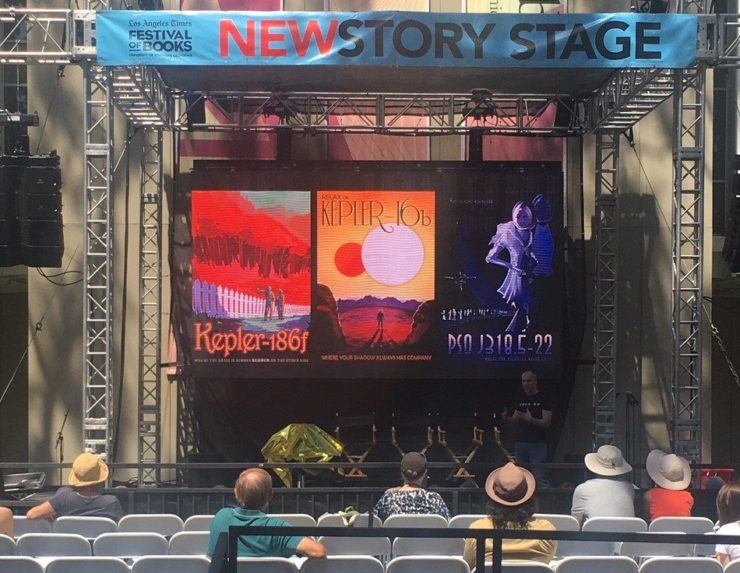The L.A. Times Book Festival, held over the weekend of April 21-22, is an annual celebration of reading and literary culture in a town often stereotyped as not exactly bookish. But Hollywood runs on stories, so this year the festival debuted a new strand of programming, Newstory, to lead visitors “beyond the book” and showcase innovations in a variety of media — from music to podcasting to virtual reality — and to grapple with the meaning, and future, of storytelling.
“A lot of people don’t want to strap a box on their face."
Storytellers have always sought to capture their readers’ attention and immerse them in another world, whether it’s the next town over, a distant country, ancient civilization or far-off planet. Innovators in what is best known as virtual reality hope to take that solitary, imaginative experience and find ways to enhance it, extend it or share it with others. But to the frustration of many of those experimenting with mind-altering, reality-bending new forms of storytelling, the futuristic dream is stuck at technological border control.
“A lot of people don’t want to strap a box on their face,” said Brett Leonard, director of the 1992 sci-fi thriller “The Lawnmower Man,” who has since become an evangelist for what he prefers to call “virtual experience.”
Unwieldy glasses and headsets, or the need for dedicated equipment and environments, remain a barrier to wider adoption of these new forms, and the prohibitive cost is one reason. Speaking on the panel “The Future of Immersive Storytelling,” Leonard drew a parallel with the past, when pioneers in the earliest days of Hollywood took a costly leap of faith that their clunky, unfamiliar technology could become a mass-market phenomenon, and he laments that studios today aren’t willing to make a similar gamble.
What willingness there is to experiment with VR lies mostly in marketing departments. Dana Nussbaum, SVP of media advertising at Warner Bros., described the pop-up installations that her team created in Hollywood to promote the movies “IT” and “Ready Player One”: a VR-enhanced haunted house and an interactive maze. Although these “experiential marketing” projects attracted thousands of curious visitors, it’s unclear whether they are creating an appetite for standalone VR experiences. No matter how creative or ambitious, there’s still a difference between trailer and the movie, between the experience selling the story and the story itself.

Closer to hand — quite literally — are the possibilities of augmented reality, or AR, which is less an immersion in a new world than another world’s incursion into ours. The social media applications we carry in our pockets already add a layer of “elsewhere” between us and the world around us, and it may be our phones that act as the “gateway drug” to other AR experiences, according to Ryan Horrigan, chief content officer at VR studio Felix & Paul. The wildly popular “Pokémon Go” app, for example, turned the whole world into a game, and created a community among millions of globally dispersed players. Other creators are attempting to push the simple puzzle elements of popular mobile games towards narrative: The iPhone game Florence unfolds a love story through the interaction between player and characters.
The challenge for any phone-based story is whether the inevitable interruptions will break the spell of immersion. But it may be that the breakthrough hit hasn’t arrived yet to convince a critical mass of users to embrace a new form. So far, there’s been no AR equivalent of “Serial,” the podcast that launched a thousand imitators and made an accessible technology ubiquitous.
More ambitious immersive storytelling projects work by gathering people at a dedicated site. At the festival a small pop-up dome allowed around 30 people at a time to watch snippets of the work of one of the presenters, Vortex Immersion Media. Inside the dome, kaleidoscopic visuals unfolded overhead in time to music, but it took some imagination to see how this kind of experience could feel immersive, rather than just colorful and loud. The company has a permanent immersive media venue in Los Angeles, and brings its domes to concerts and other live events, at which performers can use hand-held controllers to “command the environment,” as Ed Lantz, the company’s founder, described it.
One audience member asked the speakers whether they had tried VR under the influence of psychedelic drugs — although this might still be a fringe pursuit, the idea was a revealing one, as these VR experiences often look and sound like efforts to create a kind of out-of-body hallucination. Perhaps also like LSD, devotees of the mind-expanding power of VR have a hard time convincing skeptics that there’s much more to the experience than meets the eye, or nervous system.
The Vortex dome also showcased an educational project in which cartoon children scampered around a forest and the solar system. These kinds of experiences, in which students virtually explore complex systems like plants, planets and the human body, offer a powerful tool for understanding their structure and function. Researchers in science and medicine already benefit from VR’s ability to turn vast quantities of data into visual “stories.” In a presentation on the dedicated Newstory stage, Dan Goods, lead creative for NASA’s Jet Propulsion Lab, described the benefits that artists bring to a scientific research environment as “asking questions that our peers don’t ask,” and pushing researchers to understand and explain their findings in narrative and visual terms. Storytelling, in this world, is a path to comprehension, a way of taking unmanageable numbers and measurements and opening them up for interpretation.
In the more optimistic vision of the future of storytelling, however, virtual worlds can help to expand our human potential for empathy and creativity. Researchers have discovered emotional and moral benefits to reading novels, so might a deeper immersion in the story deepen those benefits too?
No matter how optimistic the proponents of virtual-reality futures may be, it is hard to escape the dystopian shadow that hangs over their discussions — any mention of the word “implant” prompts nervous laughs from the audience.
The self-styled futurist Zenka, speaking on a panel about how virtual, augmented and mixed reality will change storytelling, recounted a vivid nightmare of stabbing a zombie, a VR experience her brain had registered as real. Extreme experiences have a profound, possibly even physical, impact on the brains of young people in particular, and our brains are very bad at distinguishing what’s “real” from what’s “virtual.”
Even more innocuous possibilities — like unobtrusive glasses that add layers and filters to the world around us without anyone else knowing, letting virtual butterflies flit across our path, for instance — begin to sound unsettling as they disturb the boundary between real and imagined. In the current media climate, it is hard to feel complacent about the technological manipulation of reality when its potential disruption is so easy to imagine — an example frequently cited by the audience was the filmmaker Jordan Peele’s recent viral video using footage of President Obama spliced with his own voice, intended as a cautionary illustration of how fragile the truth can be.
In the more optimistic vision of the future of storytelling, however, virtual worlds can help to expand our human potential for empathy and creativity. Researchers have discovered emotional and moral benefits to reading novels, so might a deeper immersion in the story deepen those benefits too? While reading a book, Zenka suggested, the environment might respond by superimposing sounds or images, so that a dark and stormy night on the page could become a dark and stormy night inside your living room. The challenge would be to make those augmentations meaningful rather than merely decorative.
Interactive storytelling opposes the “passive” and active experience of a story, preferring the version in which the user, reader, viewer — or whatever we become — is free to wander and to invent. Writers, in this version of storytelling, become architects, responsible for creating the conditions for a story to come to life, rather than directing its action themselves, according to Nancy Bennett, chief creative officer of “entertainment engineers” Two Bit Circus.
The preference for users to be more directly engaged in stories is rooted in an admirable desire to democratize storytelling and to raise everyone’s voice, but the results vary widely. In online journalism, giving readers the chance to offer immediate feedback on a story was a noble impulse, but in practice, the comments section is rarely animated by a spirit of collaboration and creativity. The immersive theater production “Sleep No More,” in which the masked audience is free to explore an expansive “set” and to encounter staged scenes seemingly at random, is often cited as a successful, albeit low-tech, version of the immersive, interactive experience. Yet there is more direction involved in this production than audiences see, and the play-world itself is based on Shakespeare, hardly a futuristic story-architect. It’s hard to see how, without that direction, that story, and that language as its foundation, the experience is much more than a haunted house: fun to explore, but fairly limited as a story. If everyone is at the center of their own story, can that center really hold?
The publishing platform Medium is also underpinned by the democratic goal of giving all its users a voice, and has gone through several iterations in its effort to sustain a community of writers and engaged readers. Speaking on a Medium-sponsored panel on “the ever-evolving nature of storytelling,” the writer Carmen Maria Machado, a National Book Award finalist for her collection of short stories “Her Body and Other Parties,” described getting her start writing for websites specializing in genre fiction, which welcomed experimentation with form and structure.
It’s no surprise that the most innovative work in VR storytelling is happening in sci-fi and fantasy movie-making and gaming, genres in which world-building and relatively simple story structures, like the hero’s journey, remain paramount. Traditional literary publishers like Farrar, Straus, and Giroux have tried to make interactive novels work, but successes are rare. Perhaps it’s writers who are unwilling to cede control, to reimagine themselves as architects of story and share creative responsibilities with their readers—or perhaps for readers, “passivity” is not the automatic negative that futurists often assume it to be. Part of the pleasure of immersing oneself in a story, after all, is surrendering control to a writer who will take us somewhere we did not plan to go, or show us things we could not have seen for ourselves.



